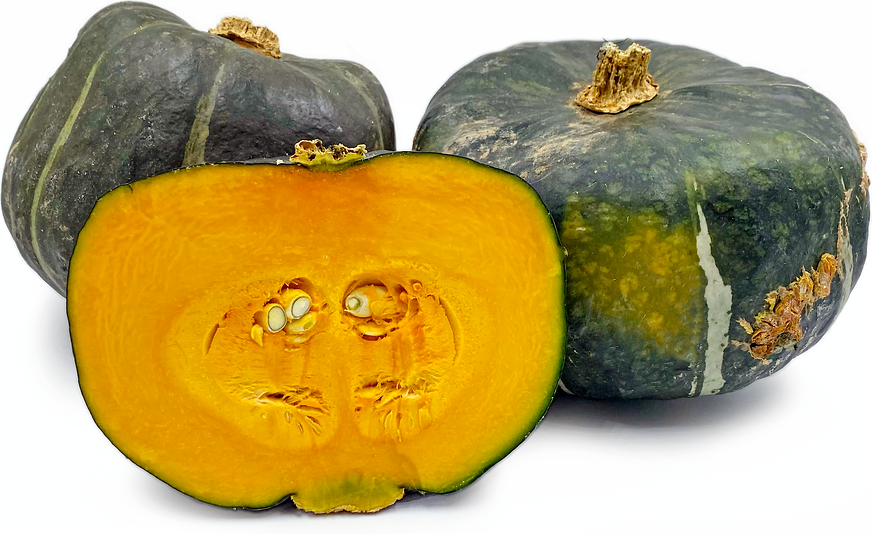


Bonbon Squash
Estimated Inventory, lb : 0
Description/Taste
Bonbon squashes have a uniform, slightly flattened, and round shape, averaging 15 to 17 centimeters in diameter, with block-like, square shoulders. The dark green-grey rind is covered in thin, silver-green stripes and is semi-bumpy and tough, connected to a brown, woody stem. Underneath the rind, the flesh is smooth, dense, and bright orange, encasing a central cavity filled with stringy pulp and many flat and oval, cream-colored seeds. Bonbon squash has a clean, green aroma similar to a cucumber when sliced fresh and when cooked, the flesh becomes creamy and smooth with a sweet, honey-like flavor.
Seasons/Availability
Bonbon squashes are available in the fall through winter.
Current Facts
Bonbon squashes, botanically classified as Cucurbita maxima, are a hybrid, winter squash variety that belongs to the Cucurbitaceae family. Selectively bred for its improved traits, Bonbon squashes are a variety of buttercup squash that are early ripening with a sweet flavor. The cultivar received its name from its honey, candy-like taste, and has an average Brix of 14-16, which is a unit of measurement for sweetness and sugar content. Bonbon squashes are a favorite variety among home gardeners in North America for its compact size, high-yields, and resistance to disease. The squashes can be used in a wide variety of cooked applications and are also popularly used as a fall decoration due to their extended storage capabilities.
Nutritional Value
Bonbon squashes are an excellent source of vitamin A, which can help improve vision, boost the immune system, and keep organs functioning properly. The squashes are also a good source of vitamin C, potassium, manganese, beta-carotene, magnesium, and fiber.
Applications
Bonbon squashes are best suited for cooked applications such as baking, steaming, or roasting. The creamy, sweet flesh can be used as a substitute for sweet potato and is a favored ingredient for pies. The squashes can also be roasted and blended into soups, mashed into a smooth side dish, used as a filling for ravioli, or added risottos, sauces, and curries. In addition to roasting, the squashes can be used as a meat substitute in stews and chilis, stuffed and baked with sweet and savory fillings, or cooked and served with spices, yogurt, or butter as a simple appetizer. Bonbon squashes pair well with herbs such as parsley, rosemary, sage, chives, and coriander, parmesan, ginger, garlic, nuts such as pine nuts, walnuts, and almonds, and meats such as beef, pork, turkey, or poultry. The fresh squash will keep up to three months when stored whole in a cool and dry place.
Ethnic/Cultural Info
Bonbon squashes were selected as an All-America Selection’s Edible Vegetable Winner in 2005 for its improved characteristics over the classic buttercup variety. The squashes were favored for their adaptability to be grown across North America, early-ripening nature, compact size, and rich, sweet flavor. All-America Selections is one of the oldest non-profit testing organizations and utilizes expert judges from all over North America to study, trial, and acknowledge quality varieties that have been created without genetic modification. The independent organization has been selecting winners since 1932 to help home gardeners make informed decisions about growing specific varieties.
Geography/History
Bonbon squashes are an improved hybrid of the buttercup squash and are bred and sold through Johnny’s Selected Seeds, based in Winslow, Maine. The squashes as considered to be a newer variety as their parent squash, buttercup, was created at North Dakota State University in the 1930s. Today Bonbon squashes are widely available through seed catalogs across the United States and are grown as a specialty variety through farms and in home gardens. Bonbon squashes are also found through specialty grocers and at farmer's markets in Canada and the United Kingdom.




